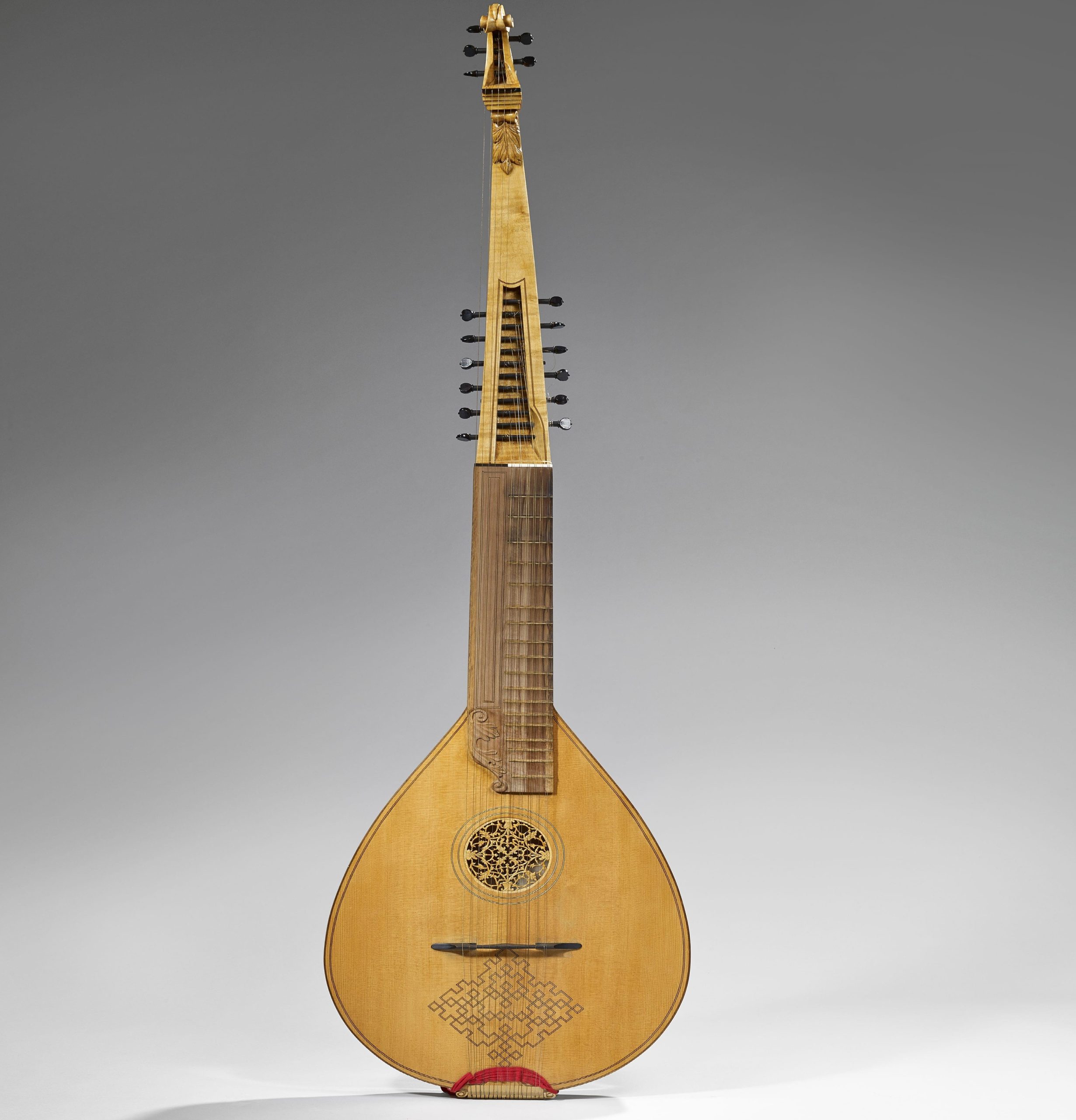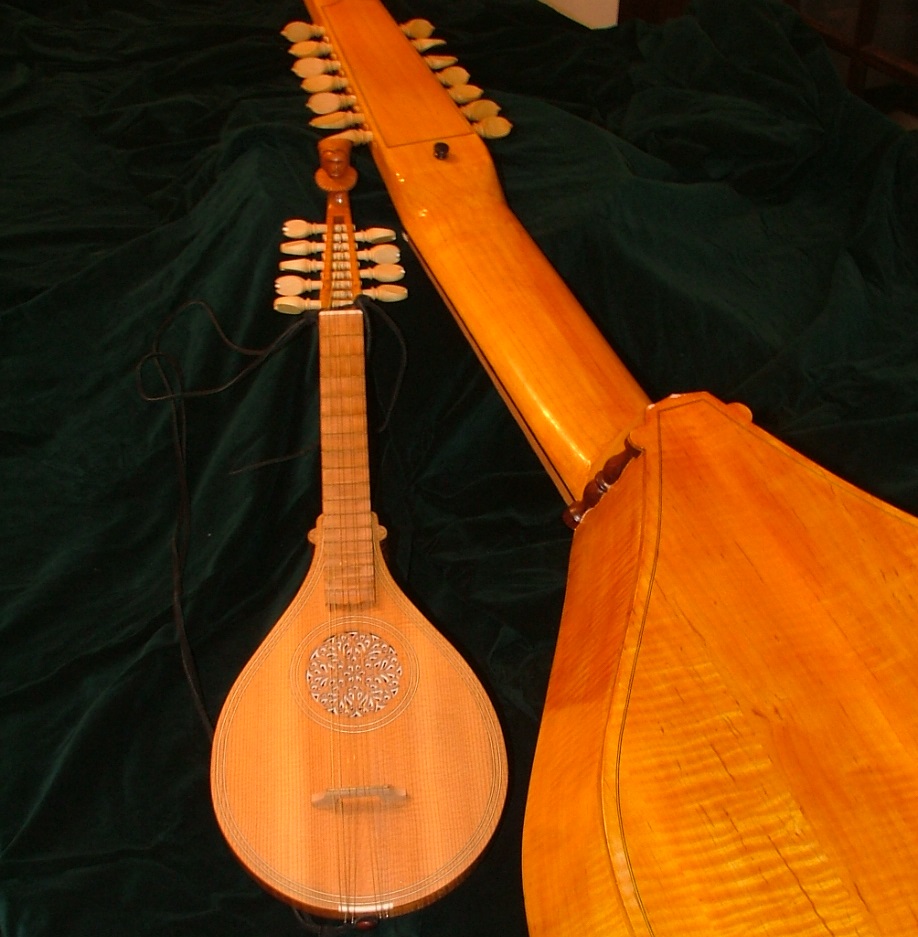Ceterone
Plucked Instruments
Europe
Between 1001 and 1900 AD
Video
The ceterone, also known as the chitarrone or theorbo, is a large, long-necked lute-type instrument primarily used for basso continuo and solo playing during the late Renaissance and early Baroque periods. It is characterized by its extended neck, which supports two pegboxes: one for the stopped strings (those that are fretted) and another for the open bass strings (diapasons).
These diapasons, running off the neck and attached to the second pegbox, provide a deep, resonant bass foundation. The ceterone’s body resembles a large lute, typically constructed from multiple ribs of wood, forming a rounded back. The soundboard, made of spruce, features a decorative rose soundhole. The strings, traditionally made of gut, are plucked with the fingers or a plectrum. The ceterone’s primary function was to provide harmonic support in ensembles, but it also served as a solo instrument, showcasing its rich tonal palette and expressive capabilities. Its dual nature, acting as both a bass instrument and a melodic instrument, set it apart from other plucked string instruments of its time.
Historical Background
The ceterone emerged in Italy during the late 16th century, specifically around the 1580s. Its development coincided with the rise of opera and the seconda pratica, a new musical style emphasizing emotional expression and dramatic contrast. The need for a bass instrument capable of providing a solid harmonic foundation while also possessing melodic flexibility led to the creation of the ceterone. The instrument’s extended neck and multiple string courses were designed to accommodate the demands of this new musical aesthetic. From Italy, the ceterone spread throughout Europe, becoming popular in France, Germany, and England. It reached its zenith during the early Baroque period, particularly in the 17th century, before gradually declining in popularity as other bass instruments, such as the cello and double bass, gained prominence. The ceterone’s history is inextricably linked to the development of Baroque music, reflecting the era’s emphasis on dramatic expression and harmonic richness. Its influence can be heard in the works of composers such as Giulio Caccini, Jacopo Peri, and Claudio Monteverdi, who frequently employed the instrument in their operas and vocal works. The instrument’s development was very much tied to the development of the Florentine Camerata, and the desire to revive ancient Greek dramatic styles within musical settings.
Construction and Design
The construction of a ceterone is a complex and intricate process, requiring the skills of a highly specialized luthier. The body, typically made of multiple ribs of cypress, maple, or yew, is carefully shaped and glued together to form a rounded back. The soundboard, made of spruce, is meticulously thinned and braced to enhance its resonance. The neck, also made of hardwood, is long and slender, providing ample space for the stopped strings. The two pegboxes, one at the top of the neck and the other extending from it, are designed to accommodate the different string lengths and tensions. The stopped strings, usually six to eight courses, are tuned in a re-entrant fashion, meaning that some of the lower courses are tuned an octave higher than expected. The diapasons, typically eight to fourteen courses, are tuned to provide a deep bass foundation. The bridge, made of hardwood, is designed to transfer the string vibrations to the soundboard. The rose soundhole, often intricately carved, serves both aesthetic and acoustic purposes. The strings, traditionally made of gut, are carefully selected and installed to achieve the desired tonal quality. The overall design of the ceterone reflects a balance between functionality and aesthetics, with every element contributing to the instrument’s unique sound and visual appeal. The sheer length of the instrument, often reaching over two meters, made it a visually impressive instrument, and a symbol of status.
Types of Ceterone
While the ceterone is generally considered a single type of instrument, variations existed in terms of size, stringing, and tuning. The most common type is the large, double-headed ceterone with numerous diapasons, used primarily for basso continuo. However, smaller versions, with fewer diapasons, were also used for solo playing and chamber music. Variations in stringing and tuning allowed for different tonal qualities and playing styles. Some ceterones were strung with metal strings, producing a brighter and more resonant sound, while others retained the traditional gut strings for a warmer and more mellow tone. The number of courses and the tuning of the diapasons also varied, depending on the specific musical context and the preferences of the player. Some instruments had a single pegbox, with the diapasons running alongside the stopped strings, while others had the more typical double-headed design. The term “chitarrone” is often used interchangeably with “ceterone,” but some scholars argue that the chitarrone refers specifically to the larger, double-headed version. The theorbo, another related instrument, is often considered a type of ceterone, but it typically has fewer diapasons and a slightly different tuning. These variations reflect the ongoing development and experimentation that characterized the early Baroque period, as musicians and luthiers sought to refine the ceterone’s design and expand its musical capabilities. The theorbo, in particular, became very popular in France.
Characteristics
The ceterone possesses a unique set of characteristics that distinguish it from other plucked string instruments. Its most notable feature is its extended neck and multiple string courses, which allow for a wide range of tonal colors and harmonic possibilities. The diapasons provide a deep, resonant bass foundation, while the stopped strings offer a rich and expressive melodic range. The re-entrant tuning of the stopped strings creates a distinctive tonal character, with a blend of high and low frequencies. The ceterone’s sound is often described as warm, mellow, and intimate, making it ideal for accompanying vocal music and chamber ensembles. Its dynamic range is also notable, allowing for subtle nuances and dramatic contrasts. The instrument’s large size and complex construction contribute to its impressive visual presence, making it a symbol of status and musical sophistication. The ceterone’s versatility is another key characteristic, as it can be used for both harmonic support and solo playing. Its ability to provide a solid bass foundation while also offering melodic flexibility made it an indispensable instrument in the early Baroque period. The instrument’s ability to sustain notes, when compared to other plucked instruments of the period, was also a notable characteristic. The ceterone’s tonal blend with the human voice was also considered a highly valued characteristic.
Playing Techniques and Sound Modifications
Playing the ceterone requires a high level of skill and dexterity. The player must be able to navigate the complex stringing and tuning, while also maintaining a steady rhythm and producing a clear and expressive tone. The left hand is used to stop the strings on the fingerboard, while the right hand plucks the strings with the fingers or a plectrum. Different plucking techniques can be used to produce different tonal colors and dynamic levels. For example, plucking closer to the bridge produces a brighter and more resonant sound, while plucking closer to the soundhole produces a warmer and more mellow tone. The use of ornaments, such as trills, mordents, and appoggiaturas, is also essential for expressive playing. The ceterone’s sound can be modified in several ways. The choice of strings, for example, can significantly affect the instrument’s tone. Gut strings produce a warmer and more mellow sound, while metal strings produce a brighter and more resonant sound. The type of plectrum used can also affect the tone. A softer plectrum produces a softer and more delicate sound, while a harder plectrum produces a louder and more forceful sound. The player can also modify the sound by adjusting the position of the right hand and the angle of the plucking. The use of vibrato, a subtle oscillation of the pitch, can add warmth and expressiveness to the tone. The ceterone’s large size and complex construction also allow for a wide range of dynamic contrasts, from subtle whispers to dramatic outbursts. The player’s knowledge of basso continuo was also a very important skill, required for most playing situations.
Applications in Music
The ceterone’s primary application in music was in basso continuo, providing harmonic support in operas, oratorios, and chamber music. Its deep bass foundation and melodic flexibility made it an ideal instrument for accompanying vocal music. It was also used as a solo instrument, showcasing its rich tonal palette and expressive capabilities. Solo ceterone music often featured intricate ornamentation and virtuosic passages. The ceterone was also used in chamber ensembles, often in combination with other plucked string instruments, such as the lute and guitar. Its versatility allowed it to adapt to a wide range of musical styles and contexts. The instrument was also used in theatrical productions, providing dramatic and emotional support to the stage action. The ceterone’s ability to create a sense of intimacy and emotional depth made it a valuable tool for composers and performers. The instrument was also used in sacred music, accompanying choirs and solo singers in church services and religious ceremonies. The ceterone’s ability to create a sense of solemnity and reverence made it an ideal instrument for this purpose. The instrument was also used in secular music, accompanying dances and social gatherings. The ceterone’s versatility and expressive capabilities made it a popular instrument in a wide range of musical settings.
FAQ
What is the history of the Ceterone?
The Ceterone, a large theorbo-like instrument, emerged in the late Renaissance and Baroque periods. It was developed in Italy as an evolution of the cittern, combining features of lutes and chitarrone. Used mainly in continuo accompaniment, it declined by the 18th century. Today, it is mainly seen in historical music ensembles.
What materials are used in the construction of the Ceterone?
The Ceterone is crafted from tonewoods like spruce for the soundboard and maple for the back and sides. Its long neck is made from hardwood, ensuring stability. Gut strings were traditionally used, though modern replicas may use nylon. The instrument also features intricate inlays and decorative rosettes.
What are the advantages of playing the Ceterone?
The Ceterone offers a rich, resonant sound with deep bass tones, making it ideal for continuo playing. Its extended neck and additional bass strings allow for greater harmonic possibilities. It provides historical authenticity in Baroque ensembles. Though rare, it adds unique texture to early music performances.
 Links
Links
References
Other Instrument
Categories



















